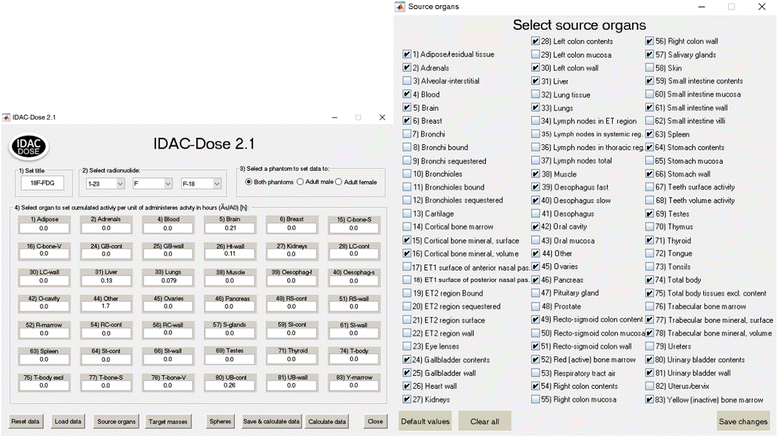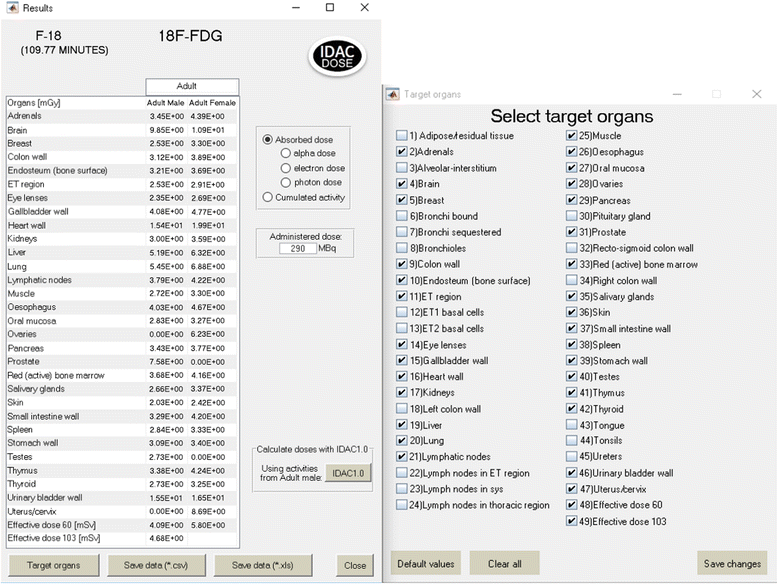IDAC-Dose 2.1, an internal dosimetry program for diagnostic nuclear medicine based on the ICRP adult reference voxel phantoms
- PMID: 29098485
- PMCID: PMC5668221
- DOI: 10.1186/s13550-017-0339-3
IDAC-Dose 2.1, an internal dosimetry program for diagnostic nuclear medicine based on the ICRP adult reference voxel phantoms
Abstract
Background: To date, the estimated radiation-absorbed dose to organs and tissues in patients undergoing diagnostic examinations in nuclear medicine is derived via calculations based on models of the human body and the biokinetic behaviour of the radiopharmaceutical. An internal dosimetry computer program, IDAC-Dose2.1, was developed based on the International Commission on Radiological Protection (ICRP)-specific absorbed fractions and computational framework of internal dose assessment given for reference adults in ICRP Publication 133. The program uses the radionuclide decay database of ICRP Publication 107 and considers 83 different source regions irradiating 47 target tissues, defining the effective dose as presented in ICRP Publications 60 and 103. The computer program was validated against another ICRP dosimetry program, Dose and Risk Calculation (DCAL), that employs the same computational framework in evaluation of occupational and environmental intakes of radionuclides. IDAC-Dose2.1 has a sub-module for absorbed dose calculations in spherical structures of different volumes and composition; this sub-module is intended for absorbed dose estimates in radiopharmaceutical therapy. For nine specific alpha emitters, the absorbed dose contribution from their decay products is also included in the committed absorbed dose calculations.
Results: The absorbed doses and effective dose of 131I-iodide determined by IDAC-Dose2.1 were validated against the dosimetry program DCAL, showing identical results. IDAC-Dose2.1 was used to calculate absorbed doses for intravenously administered 18F-FDG and orally administered 99mTc-pertechnetate and 131I-iodide, three frequently used radiopharmaceuticals. Using the tissue weighting factors from ICRP Publication 103, the effective dose per administered activity was estimated to be 0.016 mSv/MBq for 18F-FDG, 0.014 mSv/MBq for 99mTc-pertechnetate, and 16 mSv/MBq for 131I-iodide.
Conclusions: The internal dosimetry program IDAC-Dose2.1 was developed and applied to three radiopharmaceuticals for validation against DCAL and to generate improved absorbed dose estimations for diagnostic nuclear medicine using specific absorbed fraction values of the ICRP computational voxel phantoms. The sub-module for absorbed dose calculations in spherical structures 1 mm to 9 cm in diameter and different tissue composition was included to broaden the clinical usefulness of the program. The IDAC-Dose2.1 program is free software for research and available for download at http://www.idac-dose.org .
Keywords: DCAL; Diagnostic nuclear medicine; Effective dose; ICRP; IDAC; Internal dosimetry; Radiopharmaceuticals.
Conflict of interest statement
Ethics approval and consent to participate
Not applicable
Consent for publication
Not applicable
Competing interests
SM, LJ, and KE declare that they have no competing interests. MA owns stocks in the company IDAC-DOSE AB.
Publisher’s Note
Springer Nature remains neutral with regard to jurisdictional claims in published maps and institutional affiliations.
Figures



References
-
- Eckerman K, Leggett R, Cristy M, Nelson C, Ryman J, Sjoreen A, Ward R. DCAL: User's guide to the DCAL system. ORNL/TM-2001/190. Oak Ridge National Laboratory. ANNEXE. 2006.
-
- Johansson L. Patient irradiation in diagnostic nuclear medicine: assessment of absorbed dose and effective dose equivalent dosimetry [doctoral thesis] Gothenburg, Sweden: Gothenburg University; 1985.
-
- Andersson M, Johansson L, Minarik D, Mattsson S, Leide Svegborn S. An upgrade of the internal dosimetry computer program IDAC. In: Adlienè D, editor. Medical physics in the Baltic states 2012. Kaunas: Technologija. 2012. pp. 120–123.
-
- Stabin M. MIRDOSE: personal computer software for internal dose assessment in nuclear medicine. J Nucl Med. 1996;37:538–546. - PubMed
-
- Stabin M, Sparks RB, Crowe E. OLINDA/EXM: the second-generation personal computer software for internal dose assessment in nuclear medicine. J Nucl Med. 2005;46:1023–1027. - PubMed
LinkOut - more resources
Full Text Sources
Other Literature Sources
Medical

